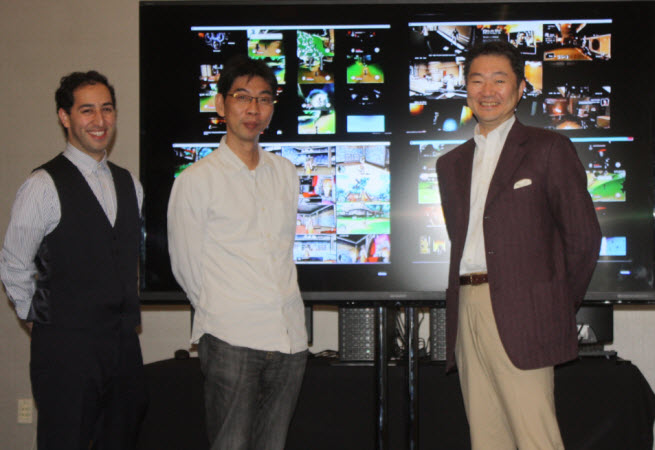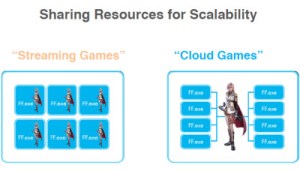GamesBeat: Are you already working on some games that prove out the Flare idea?
Wada: At the moment, there’s nothing we can announce. But because of this presentation, the word is beginning to spread. We’re looking forward to receiving a lot of feedback and input.
GamesBeat: Does the name “Flare” itself mean something?
Navok: Mr. Iwasaki, do you want to explain that one [Laughter]?
Tetsuji Iwasaki: It’s random.
Wada: The answer changes every day, so if you ask him tomorrow, he’ll tell you something new.
Navok: There’s no particularly deep meaning, as far as I know.
GamesBeat: Improvements in hardware and the grid are helping you. Are you doing something new and different that’s making a difference in costs, scalability, and efficiency?
Navok: If we look at why we initially went about creating this technology, it started about three years ago, when Mr. Wada, Mr. Iwasaki, and myself were having discussions about cloud gaming. Wada was a big believer that cloud was the future, that rendering and processing would all shift to the data center. As we looked at the first crop of companies that came out there, we had high expectations. We were involved in OnLive. We did a lot of experiments with different cloud companies. But we were very disappointed that none of them had a technological breakthrough.
What I mean by that is, they didn’t change the way games were played or designed. So we started studying this. We looked at what technology was powering this, and we realized that it was just an extension of remote desktop, basically. You were encoding something, sitting on top of the game, and streaming the game as-is. But if you really wanted to take advantage of all this distributed computing power in the data center, you had to change the software layer. You had to go into that API level where the game was interacting with the final rendered image and distribute that across all of those processors.
That discussion we had was what inspired us to go into research and development, which we started about a year and a half ago, and test our theories. The result of those tests is what you’re seeing in Project Flare today. We found that we could scale well and reduce latency. All those things that we thought we could do, when we started [research and development], we actually hit them. It was fairly shocking.
Wada: You might notice that there are two different descriptors in the presentation — streaming games and cloud games. A streaming game is what people called cloud gaming, but we felt like they were quite disappointing. That’s why we like to differentiate between the two.
Navok: Let’s say you have two multiplayer games being streamed from a data center somewhere with one of the existing cloud providers. They’re being rendered right next to each other physically, but in completely separate cycles. They’re going out to some data center somewhere and then coming back separately from each other. It doesn’t make much sense. If they’re next to each other, they should be talking to each other and sharing their processing power and using it efficiently. We didn’t see that.
GamesBeat: It sounds like it definitely differs from Microsoft’s approach in that its interested in hybrid processing between Xbox One and the cloud. That method offloads AI and physics sometimes to the cloud. You guys are mostly doing the processing in the cloud.
Navok: You can look at two different ways of thinking about the cloud. There’s the idea of rendering the game as-is and streaming it, and there’s the idea of offloading some processing. But nobody ever combined those ideas together. You get an exponentially better result when you do that because when the processing of physics and the rendering are both taking place on that server, you have added efficiency. You have added scalability. We’re hoping to harness that power, because we think that when we do, new kinds of games will result.
It’s also really nice, when you start to offload these calculations, to not have to worry about what the final latency to the user is going to be because the rendering and the physics processing are located near enough to each other to be calculated for our final frame at a very quick speed.
GamesBeat: Are you still maximizing the hardware in the local machine?
Navok: The client? No. It’s just video being decoded at the final end. We’re not trying to do hybrid at this point. I’m sure other people will try to do that, but we’re focused to the extent possible on maximizing processing in the data center because that’s where we think efficiency comes from.
GamesBeat: Microsoft has a demo of an asteroid belt. The Xbox One rendered 40,000 asteroids. Then, when the console went out to the cloud, it added hundreds of thousands of asteroids to the same field. This sounds very similar to what you’re doing with the Shibuya demo.Navok: It’s starting to grow similar. But we don’t have to worry about whether the user is going to be connected to us in the end. That’s a big concern for developers. If you’re going to design a game function where you can’t guarantee if the player is going to be able to access that function, how much do you invest in developing that function?
GamesBeat: Pull the plug and it’s 40,000 asteroids again.
Navok: Yeah. Let’s say that we want to go and put in those hundreds of thousands of asteroids in there. But we can’t guarantee that every user will see them.
GamesBeat: Is this one of Square Enix’s biggest investments as far as new game technology goes?
Wada: When it comes to the amount of investment we’ve put in, it’s not as enormous as you might imagine. What we’ve put in is our wisdom and experience in research and development.
Navok: But we have used a lot of the time of our senior management.
VentureBeat's mission is to be a digital town square for technical decision-makers to gain knowledge about transformative enterprise technology and transact. Learn More



